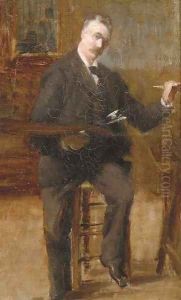Louis Joseph Anthonisse Paintings
Louis Joseph Anthonisse was a Belgian artist born on June 3, 1870, in Antwerp. His artistic journey is less documented than many of his contemporaries, and as such, specific details about his life and training may be sparse in historical records. Nevertheless, he is known to have developed a body of work that includes genre scenes, landscapes, and portraits, reflecting the styles and interests of late 19th and early 20th-century European art.
Anthonisse's work was influenced by the broader movements of his time, such as Realism and Impressionism, which were prominent in Europe. These movements focused on capturing everyday scenes and the effects of light in a more naturalistic manner, moving away from the grand historical and mythological subjects that had dominated much of 19th-century academic art. Anthonisse's genre scenes, which often depicted the daily lives of the Belgian people, were a reflection of this shift in artistic focus.
Throughout his career, Louis Joseph Anthonisse participated in various exhibitions, likely including local and regional art shows, which were common platforms for artists to gain recognition and sell their work. His paintings would have appealed to the burgeoning middle classes of the time, who were interested in decorating their homes with works of art that reflected their own lives and environments.
Anthonisse continued to create art until his death on April 25, 1944, in Borgerhout, which is a district of Antwerp. Details about his personal life, such as his marital status, family, and educational background, are not well-documented, which is not uncommon for artists of that era who did not achieve widespread fame. Today, Louis Joseph Anthonisse's works are part of private collections and may occasionally appear in auction houses, where they serve as examples of the regional art movements of Belgium during the turn of the century.
